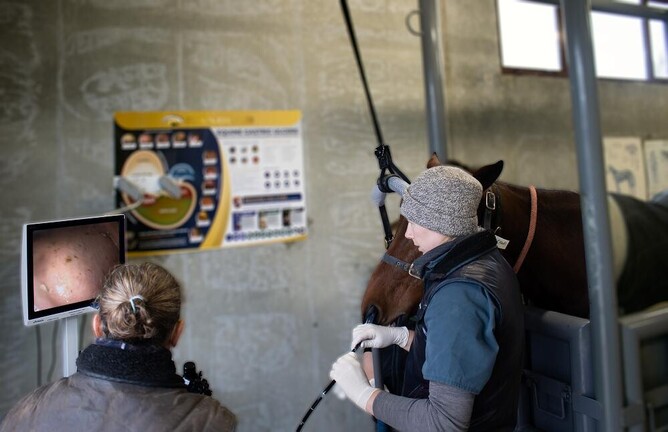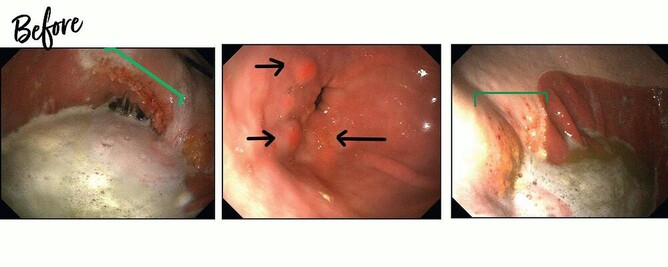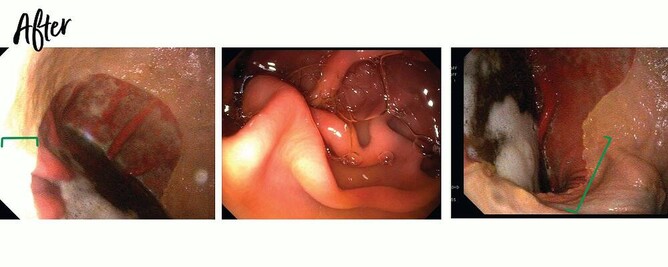Equine Gastric Ulcer Syndrome (EGUS) is an increasingly recognised condition in our equine population as a cause of behavioural issues and poor performance.
It is thought that between 60-90% of performance horses (sport and racehorses) suffer from gastric ulcers. The higher the intensity of work, the more likely a horse is to be affected.If your horse displays any or all of these symptoms, gastric ulcers should be considered a differential diagnosis:
- Poor appetite
- Dullness
- Attitude changes or changes in behaviour under saddle
- Girthiness
- Decreased performance or reluctance to train
- Poor body condition, or weight loss
- Rough hair coat
- Low grade, recurrent colic
ESGD
ESGD is caused by acid in the stomach contacting the unprotected lining at the top of the stomach. This area has no in-built protection against acid, as is found in the lower part of the stomach. This causes significant damage to the stomach lining which is uncomfortable for the horse.
This condition is primarily a feed-based issue. Environmental changes, such as ensuring sufficient long fibre roughage, increasing turnout time, decreasing dietary concentrates and feeding prior to exercise and travel, are often employed alongside omeprazole treatment.
EGGD
EGGD affects the area surrounding the entrance to the small intestine, called the pylorus. This part of the stomach has in-built mechanisms to protect the lining from the acid it produces. However, in some conditions, these aren’t sufficient or do not function correctly.
Lesions in this area are thought to be related to stress rather than dietary issues. Alongside medical therapy, environmental changes such as decreasing the frequency of rides over the week, shortening ride times and minimising the number of handlers/riders that a horse comes into contact with are also important.
Diagnosis and treatment
We now have the ability to definitively diagnose EGUS and differentiate between the different conditions with a gastroscope. This is a long fibre-optic camera that allows us to visualise the stomach and the pylorus. It is passed down the nostril via the oesophagus to the stomach after a 20-24 hour period of fasting.
Ulcers can then be graded according to the severity from 0-4. Those at the entrance of the small intestine are also described according to appearance eg. haemorrhagic or nodular. Appearance and location of the ulcers can be very important to direct the treatment plan.
The only effective treatment for EGUS is a drug called omeprazole. It acts to decrease the acidity of the stomach acid, allowing ulcerations to heal.
Sucralfate is another drug which forms a protective coating over the lesions that is often utilised with EGGD. The treatment protocol is also very important:
- Omeprazole must be administered on an empty stomach in the early morning (5-6 am) if the horse is on pasture.
- Or, following a short fast if stabled, as efficacy is compromised in the presence of feed.
- It should also be administered at least 30 minutes before further hay or hard feed is given.
- Gastroscopy is ideally performed prior to starting treatment with omeprazole.
- Repeat gastroscopy can then be used to monitor the healing and further direct the treatment programme.
Our clinic is currently offering monthly gastroscopy clinics to investigate cases we suspect are affected with EGUS. We have had some very rewarding results implementing treatment plans with the additional information the gastroscope allows us to gather.
Case study
The following case is a sport horse who presented with aggressive behaviour, weight loss and girthiness after a recent change in environment.
Grade 2-3/4 ulcerations were seen on the greater and lesser curvature of the stomach (EGSD) and there were raised, inflamed nodules surrounding the pylorus (EGGD).
The owner reported a significant improvement in the horse’s demeanour and some weight gain was also seen over this time. An excellent result!
If you have any concerns that your horse or pony is affected by EGUS, please contact the clinic to discuss with a veterinarian. This is only a brief overview of what can be a complex disease process, so please contact us for more information.
- Grace Reed



